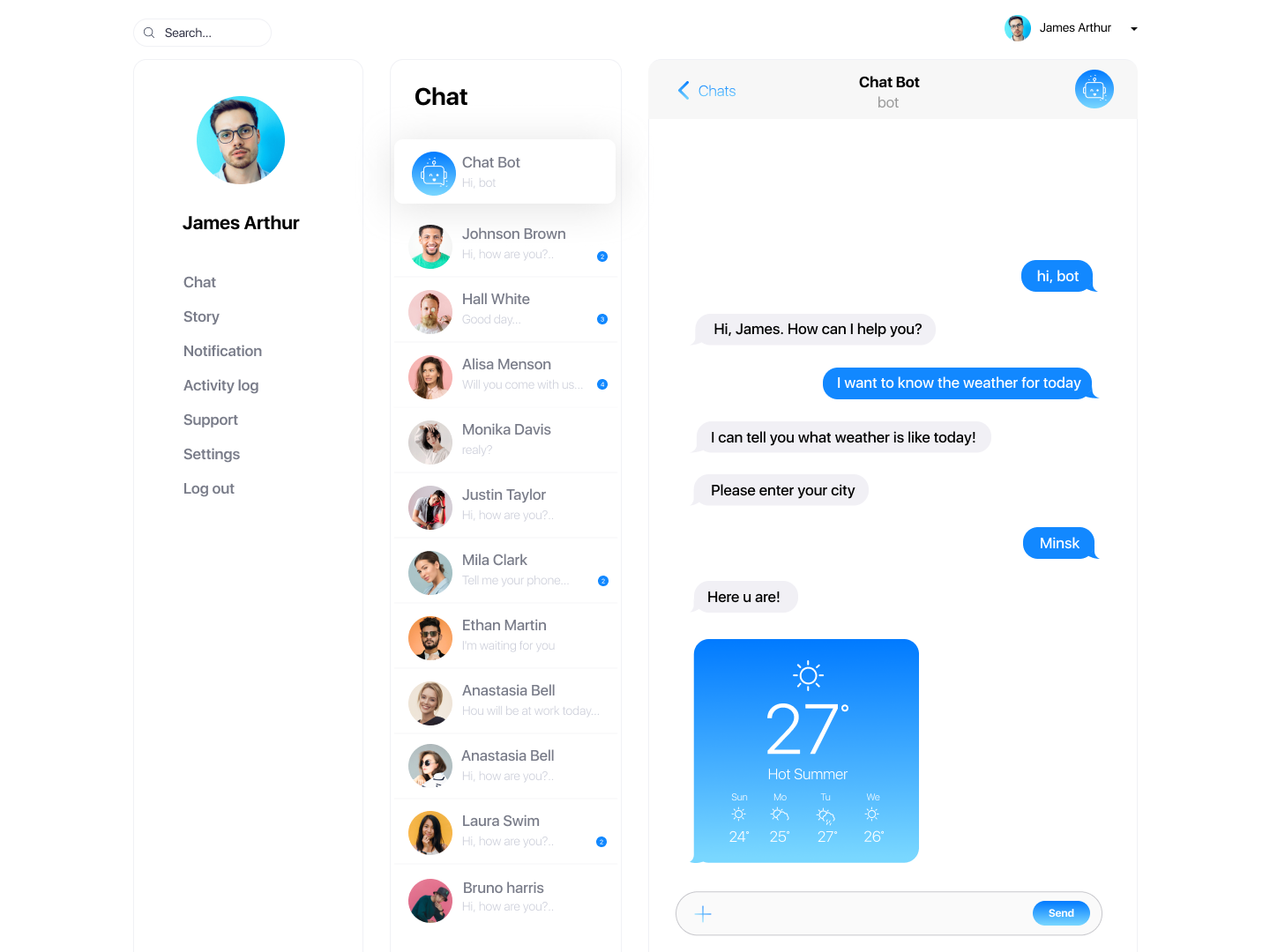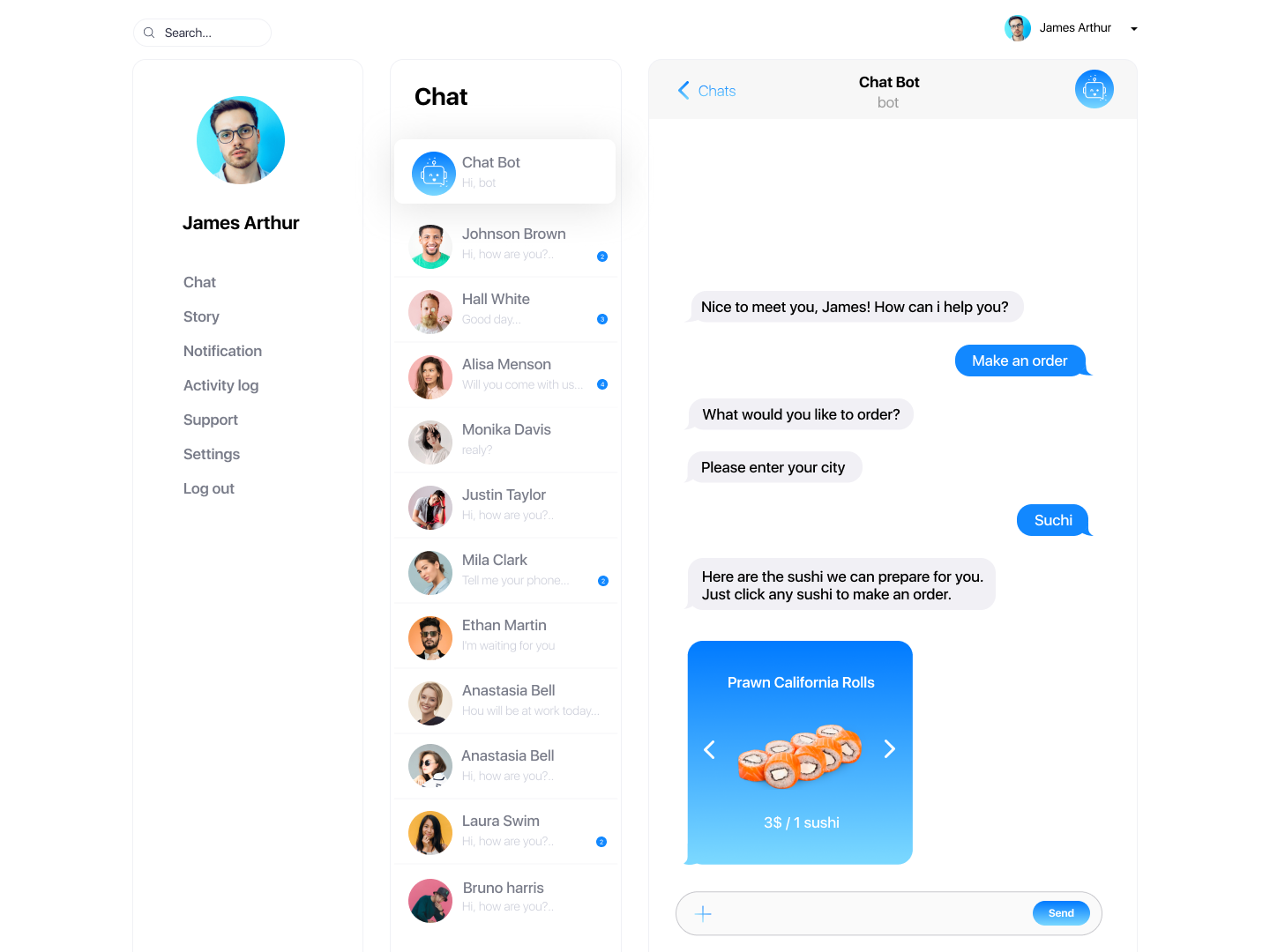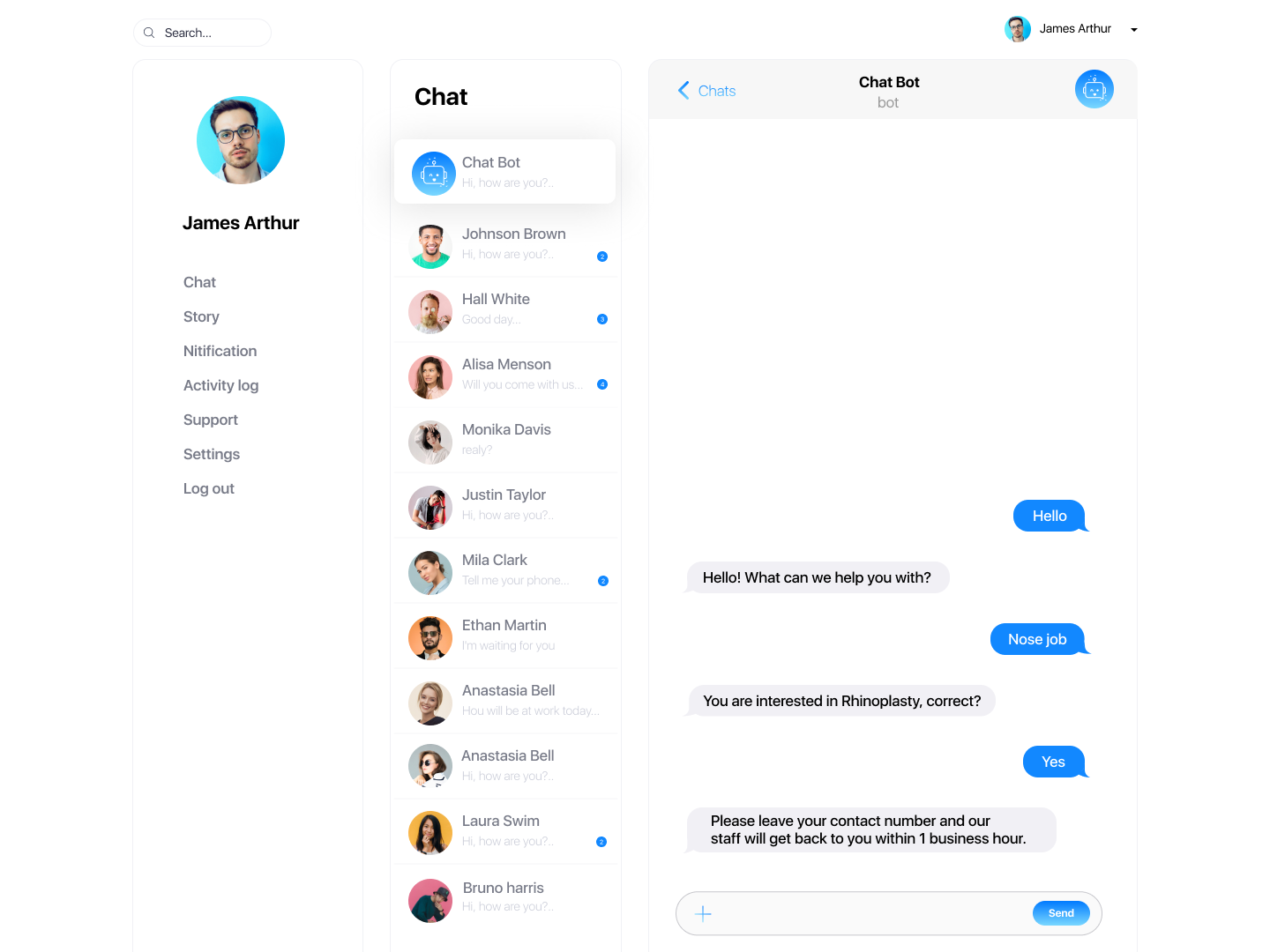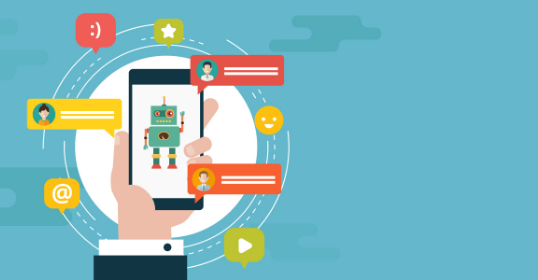Use cases of AI chatbots for Learning and Development in corporates
1. Employee coach
Corporate learning is not something people love. But it doesn’t have to be this way. And when the companies compete for better employees, good learning opportunities can be an edge.
The learning process can be performed through a Facebook messenger bot which trains and quizzes employees. It is designed with microlearning approach in mind – small chunks of information for brief attention spans. The bot can adapt messages to individual employees and boasts a 98% engagement rate.
The developers of such chatbots claim that corporate learning bots can save employees about 2-5 days per year which would be spent on actual work, rather than study.
2. Curriculum Customizer
Personalized learning is one of the top trends right now. Just as chatbots are. No wonder people look for ways to combine them.
Released a month after Facebook messenger, MOOCBuddy was a bot for finding the right Massive Open Online Course (MOOC). Services like Coursera or edX made online learning widely available but choosing the right class was still a problem. MOOCBuddy talked to people and suggested courses based on the topic, language, duration, accreditation and several other factors. It also sent reminders and updates, unless the users opted out. MOOCBuddy was likely the first chatbot of its kind, but at the moment it is no longer available.
The concept is still alive, however. Magpie continues the idea. Besides suggesting optimal courses based on user’s profile, it can also recommend educational information in public domain: TED, HBR, BBC and more.
The bot begins by asking user several questions to determine their job, position, and industry. That is enough to get a quick recommendation. But if the user provides details like workday structure or skills self-assessment, Magpie can create a detailed list.
The bot doesn’t eliminate human involvement. The content that it suggests is taken from a database approved by living, breathing editors.
Use cases of AI chatbots for improving student’s learning experience
Across the world, classes have migrated online, and often educators cannot personally reach students for teaching, giving feedback, or encouraging them to enroll. It is elevating the use of chatbots in the education sector that serve now as a medium of student-teacher communication. The AI chatbot comes especially handy as:
Virtual tutoring tool to personalize every lesson and engage students.
Tool for students’ support 24/7 to get instant answers to common questions and to manage students’ life effectively.
1. Virtual tutoring with AI chatbots
The most useful application of AI in education is automated, intelligent tutoring. The AI chatbots can help teach students using a series of messages, just like a common chat conversation, but made out of a lecture. A chatbot can test students, give questions, and assess them.
Students do not need to contact their teachers and wait a few hours for the information. They can send a message directly to an educational AI chatbot and get real-time scaffolded support with instruction and continuous assessment.
Such on-demand support helps students become independent learners by reducing student frustration and by providing appropriate guidance at the moment of struggle. Also, such a tutor chatbot opens up the teacher’s time to engage with students one-on-one.
The chatbot assesses every student’s level of understanding and then provides them with the following parts of a lecture according to their progress. And because data is constantly collected along the way, the chatbot can identify the skills students need to work on to increase their score and will suggest practicing the skill again.
Knowre
Another popular AI chatbot application is language learning. A good example is Duolingo that has been investing in AI and machine learning to make language learning more engaging by automatically tailoring lessons to each individual — kind of the way a human tutor might.
The great thing about using an AI bot is that it will get smarter the more it is used.
The purpose of an AI-powered chatbot is to simulate a human for practicing scenarios that users are likely to encounter. They focus principally on functional skills and prepare students to use their language skills in the real world.
The language learning chatbots use AI algorithms to understand the user context and be able to answer contextually and uniquely. It means that every user gets a different response for a similar inquiry.
Duolingo
2. Virtual students’ support 24/7 with AI chatbots
64 percent of internet users consider 24-hour availability to be the best feature of chatbots. For schools, colleges, and universities, which don’t operate 24/7, chatbots are a way for students to get answers instantly whatever the time.
When a teacher has a bunch of students to teach, answering repetitive questions about lesson plans, classes, and schedules is tiring and time-consuming. That’s when AI chatbots and virtual assistants come especially handy.
Artificial Intelligence chatbots and virtual assistants don’t just answer simple questions or tell students what the temperature will be tomorrow, but they can organize student’s life on a personal level by proactively taking actions and managing tasks on their behalf.
The most famous AI-powered virtual assistant chatbot is Genie, developed and implemented at Deakin University, Australia. Presented through a mobile application, it leverages chatbots, artificial intelligence, voice recognition, and a predictive analytics engine to deliver personalized advice and services, guided assistance, and curated content. It gives students easy access to their unit information, results, timetable, or answers to common student questions.
Genie
Genie is a proactive agent. So if you have an exam in two days and you haven’t been reading the material, Genie is going to remind you that the exam is coming up and you haven’t touched your material,” Deakin's chief digital officer William Confalonieri said. “To know that, we need to know that you haven’t been reading material (because the learning management system hasn’t been accessed) - we collect all that information in a predictive analytics engine that gathers data and allows Genie to react.”
However, software developers realize the limits of AI and use AI chatbots to facilitate conversations with the right support staff when needed.
Need your own chatbot? Contact us for a free quote!
Use cases of AI chatbots for improving educators’ productivity
To educational leaders who struggle to reach a generation that shuns official websites and mass emails, the use of a chatbot in education solves the issue. The reason is students feel communicating in chats more personal. Besides, chatbots are available 24/7 and respond instantly. The response time for 99 percent of queries ranges from 6 to 10 seconds.
The increasing number of administrations and teachers recognize this cost-effective and valuable way to keep their students hooked and streamline educational and administrative processes more efficiently. For education stakeholders, AI-powered chatbots come especially handy as:
Tool for automation of administrative tasks to save educators’ time and switch their focus on more critical tasks.
Tool for gathering feedback about learning material to understand the efficiency of teaching methods and improve the curriculum.
1. Automation of administrative tasks with AI chatbots
Admission & Enrollment
Forward-thinking educational leaders use AI-powered chatbots both to relieve admissions staff work by answering repetitive questions and to reach students for matters like encouraging them to enroll.
Using a chatbot reduces the summer melt, the phenomenon when students who apply and are accepted to a college fail to enroll. Summer melt affects 22,8% of college-intending high school graduates each year.
By using the AI chatbot to send personalized reminders and walk students through admission processes, Georgia State University reduced summer melt by 19 percent in the first year of implementation and increased the percentage of students completing pre-enrollment processes.
An AI virtual chat assistant can answer questions about documents or deadlines and give instructions. Answer common inquiries about types of financial aid (e.g. grants, scholarships, loans) and provide standard fees info.
The chatbot isn’t just the recipient of inquiries and questions – schools, colleges, and universities can use it to proactively send reminders, messages, or news.
AdmitHub
Retention
Poor support is one of the reasons students drop out of college. This means it is necessary for every institution to always guide their students by giving them timely and accurate information. But with no optimization, it is almost impossible to ensure each student is getting proper support.
That’s when AI-chatbots come to help. They are programmed to answer common questions instantly and help students with administrative topics 24/7.
An AI chatbot has a knowledge database based on real students’ conversations. Once it gets a question, a bot responds in seconds. However, when a bot doesn’t know an answer, the question is sent to a human team. As a human answers new questions, the AI learns by adding new data to its database. It leads to the chatbot’s capability of handling an increasing array of circumstances and questions without human input.
2. Gathering feedback about learning materials with AI chatbot
Seeing students’ performance is easy for a teacher. Understanding which of your methods contributed to achieving such performance is another thing entirely. AI chatbots are ideal for teachers and institutes to collect students’ feedbacks. Its usage upgrades the learning processes thanks to increasing the participation of students.
Replacing the traditional surveys, a chatbot talks to students via a special messenger and processes their feedbacks, letting the teacher know what works well, what is ineffective, and what else they can implement.
HelloTars
As the answers are coming in, the AI software analyzes the semantics of what the students have said and prepares a report that a teacher or administrator can review.
NLP and ML are those technologies that can analyze the feedback and understand the sentiment, looking for specific nouns or verbs as well as positive or negative words, the frequency of certain words to derive the overall tone. Then feedbacks are divided into positive (green), neutral (grey), and negative (red) based on the words and associated emotions.
As a result, educators can understand the pain points faced by dissatisfied students and find out effective ways to identify and remove those bottlenecks.
Belitsoft specializes in both chatbots and e-learning. If you have a project in mind, contact us for a free quote. No strings attached.
How to implement AI chatbot in education
Building AI chatbots in eLearning differs a lot from basic Q&A bots and needs a thorough analysis.
Implementing an AI chatbot for educational institutions may include the following stages:
Start with the analysis of your objectives. Based on the primary needs of your administration, teachers, and students, it’s necessary to decide what features your chatbot must have and what tasks it must solve. The use cases described in this article can help you analyze.
Find an expert development and consulting team. Building an AI bot capable of a human-like conversation requires highly professional programming skills, thorough analysis, and strategy. That's why many educational stakeholders decide to hire outsourcing companies to implement their ideas professionally, cost-effectively, and fast. Such services usually cover all the stages of the bot implementation and include consulting, development, and post-launch support, saving educators’ time and headache.
Test your chatbot. At this stage, an AI-powered chatbot is tested to communicate with a restricted group of real students to see if it can be helpful and resolve the assigned task.
Deploy and assess. Deploying a chatbot is not time-consuming. Your development team will just need to ensure that all endpoints are connected, and the bot is integrated with your entire infrastructure.
AI chatbots in the education industry can be used both to optimize the teaching process and to make the learning process more engaging and personalized for students. They can also significantly reduce the workload of the administrative staff of the educational institutions. As a result, we can expect an immense growth of the education sector, beneficiary interactions between students and educators, and a superior classroom environment.
Feel like starting your own eLearning project yet? Hire a dedicated team for it!
Dmitry Baraishuk
•
7
min read





















.png)
.jpg)
.jpg)
















We have been working for over 10 years and they have become our long-term technology partner. Any software development, programming, or design needs we have had, Belitsoft company has always been able to handle this for us.
Founder from ZensAI (Microsoft)/ formerly Elearningforce